2016 TOYOTA TUNDRA spare wheel
[x] Cancel search: spare wheelPage 478 of 588
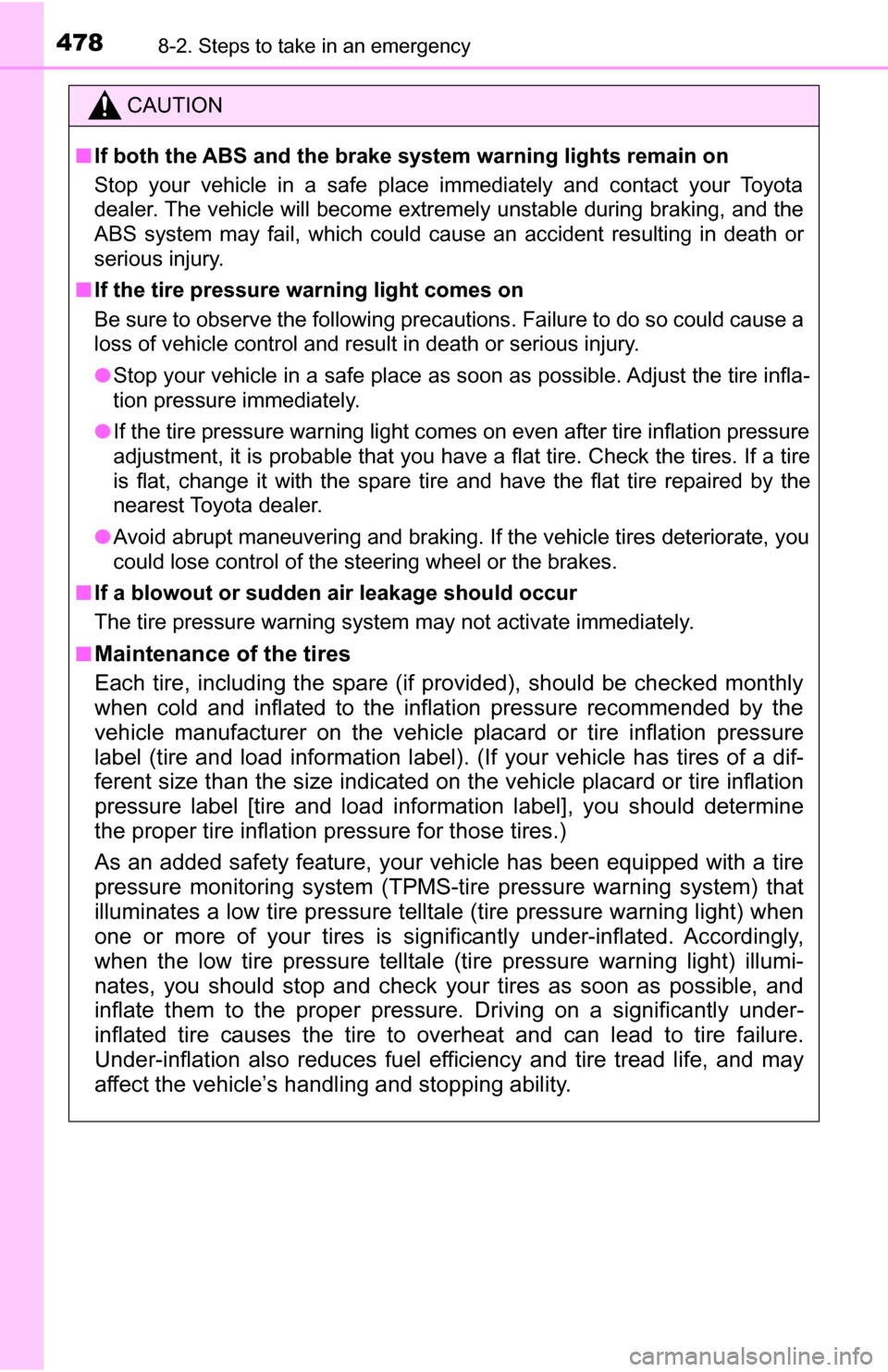
4788-2. Steps to take in an emergency
CAUTION
■If both the ABS and the brake system warning lights remain on
Stop your vehicle in a safe place immediately and contact your Toyota
dealer. The vehicle will become extremely unstable during braking, and the
ABS system may fail, which could cause an accident resulting in death or
serious injury.
■ If the tire pressure warning light comes on
Be sure to observe the following precautions. Failure to do so could cause a
loss of vehicle control and result in death or serious injury.
● Stop your vehicle in a safe place as soon as possible. Adjust the tire infla-
tion pressure immediately.
● If the tire pressure warning light comes on even after tire inflation pressure
adjustment, it is probable that you have a flat tire. Check the tires. If a tire
is flat, change it with the spare tire and have the flat tire repaired by the
nearest Toyota dealer.
● Avoid abrupt maneuvering and braking. If the vehicle tires deteriorate, you
could lose control of the steering wheel or the brakes.
■ If a blowout or sudden air leakage should occur
The tire pressure warning system may not activate immediately.
■
Maintenance of the tires
Each tire, including the spare (if provided), should be checked monthly
when cold and inflated to the inflation pressure recommended by the
vehicle manufacturer on the vehicle placard or tire inflation pressure
label (tire and load information label). (If your vehicle has tires of a dif-
ferent size than the size indicated on the vehicle placard or tire inflation
pressure label [tire and load information label], you should determine
the proper tire inflation pressure for those tires.)
As an added safety feature, your vehicle has been equipped with a tire
pressure monitoring system (TPMS-ti re pressure warning system) that
illuminates a low tire pre ssure telltale (tire pressure warning light) when
one or more of your tires is significantly under-inflated. Accordingly,
when the low tire pressure telltale (tire pressure warning light) illumi-
nates, you should stop and check your tires as soon as possible, and
inflate them to the proper pressure. Driving on a significantly under-
inflated tire causes the tire to overheat and can lead to tire failure.
Under-inflation also reduces fuel effi ciency and tire tread life, and may
affect the vehicle’s handling and stopping ability.
Page 484 of 588

4848-2. Steps to take in an emergency
If you have a flat tire
●Stop the vehicle on a hard, flat surface.
● Set the parking brake.
● Shift the shift lever to P.
● Stop the engine.
● Turn on the emergency flashers. ( P. 464)
Your vehicle is equipped with a spare tire. The flat tire can be
replaced with the spare tire.
For details about tires: P. 4 2 4
CAUTION
■
If you have a flat tire
Do not continue driving with a flat tire.
Driving even a short dist ance with a flat tire can damage the tire and the
wheel beyond repair, which could result in an accident.
Before jacking up the vehicle
Page 493 of 588
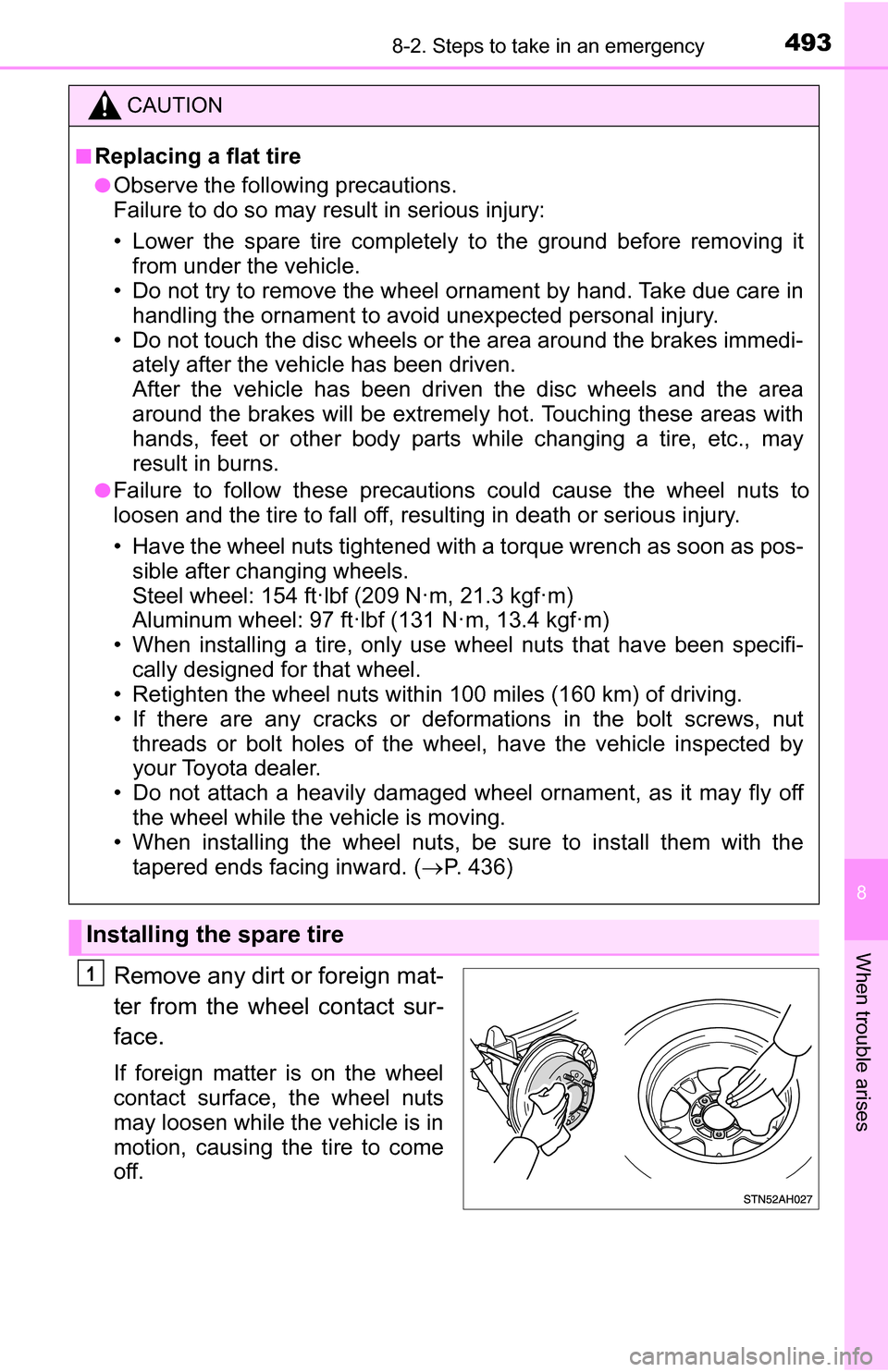
4938-2. Steps to take in an emergency
8
When trouble arises
Remove any dirt or foreign mat-
ter from the wheel contact sur-
face.
If foreign matter is on the wheel
contact surface, the wheel nuts
may loosen while the vehicle is in
motion, causing the tire to come
off.
CAUTION
■Replacing a flat tire
●Observe the following precautions.
Failure to do so may result in serious injury:
• Lower the spare tire completely to the ground before removing it from under the vehicle.
• Do not try to remove the wheel ornament by hand. Take due care in handling the ornament to avoid unexpected personal injury.
• Do not touch the disc wheels or the area around the brakes immedi- ately after the vehicle has been driven.
After the vehicle has been driven the disc wheels and the area
around the brakes will be extremely hot. Touching these areas with
hands, feet or other body parts while changing a tire, etc., may
result in burns.
●Failure to follow these precautions could cause the wheel nuts to
loosen and the tire to fall off, resulting in death or serious injury.
• Have the wheel nuts tightened with a torque wrench as soon as pos-sible after changing wheels.
Steel wheel: 154 ft·lbf (209 N·m, 21.3 kgf·m)
Aluminum wheel: 97 ft·lbf (131 N·m, 13.4 kgf·m)
• When installing a tire, only use w heel nuts that have been specifi-
cally designed for that wheel.
• Retighten the wheel nuts within 100 miles (160 km) of driving.
• If there are any cracks or deforma tions in the bolt screws, nut
threads or bolt holes of the wheel, have the vehicle inspected by
your Toyota dealer.
• Do not attach a heavily damaged wheel ornament, as it may fly off
the wheel while the vehicle is moving.
• When installing the wheel nuts, be sure to install them with the
tapered ends facing inward. ( P. 436)
Installing the spare tire
1
Page 494 of 588
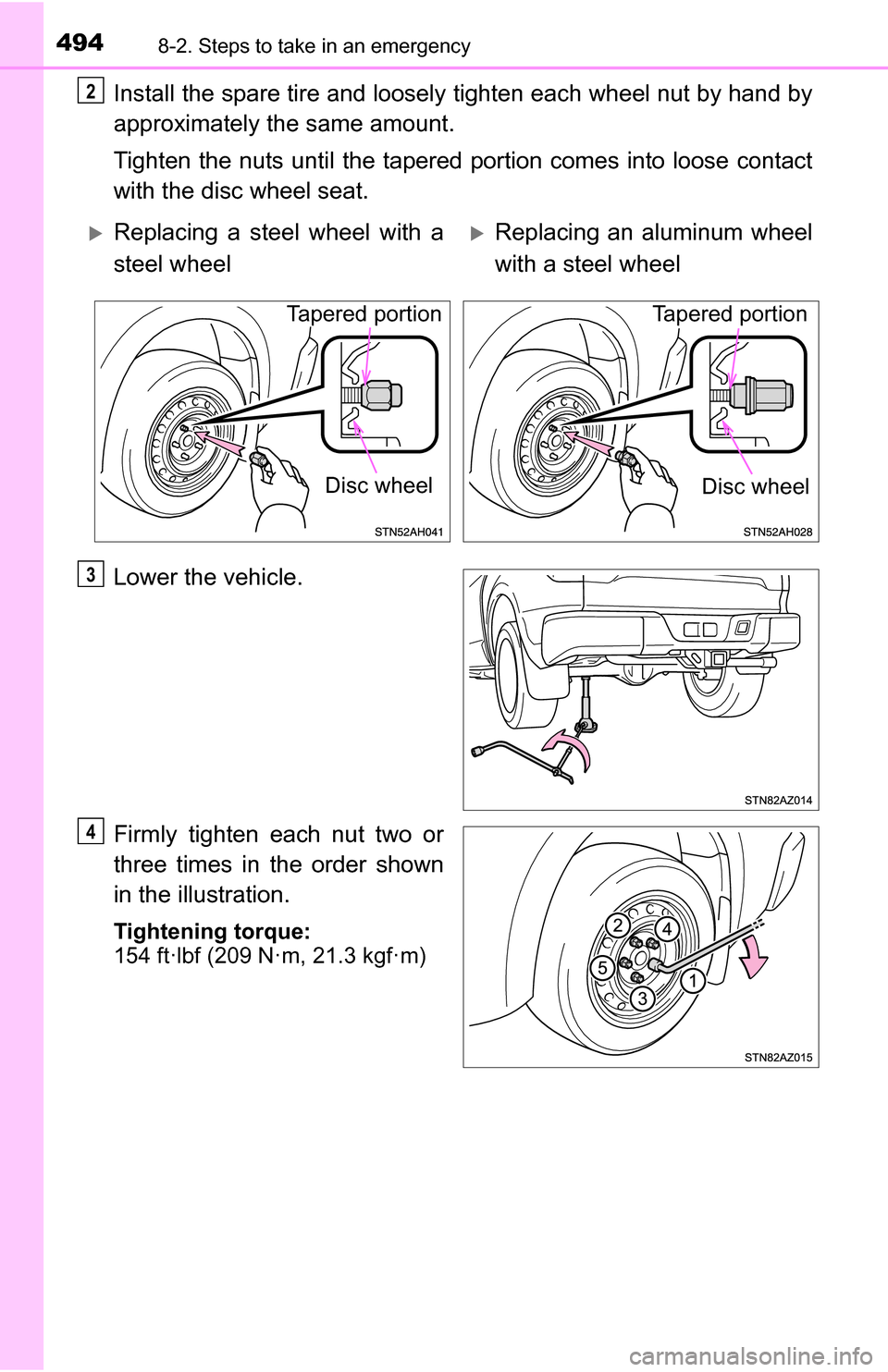
4948-2. Steps to take in an emergency
Install the spare tire and loosely tighten each wheel nut by hand by
approximately the same amount.
Tighten the nuts until the tapered portion comes into loose contact
with the disc wheel seat.
Lower the vehicle.
Firmly tighten each nut two or
three times in the order shown
in the illustration.
Tightening torque:
154 ft·lbf (209 N·m, 21.3 kgf·m)
2
Replacing a steel wheel with a
steel wheelReplacing an aluminum wheel
with a steel wheel
Tapered portion
Disc wheel
Tapered portion
Disc wheel
3
4
Page 495 of 588
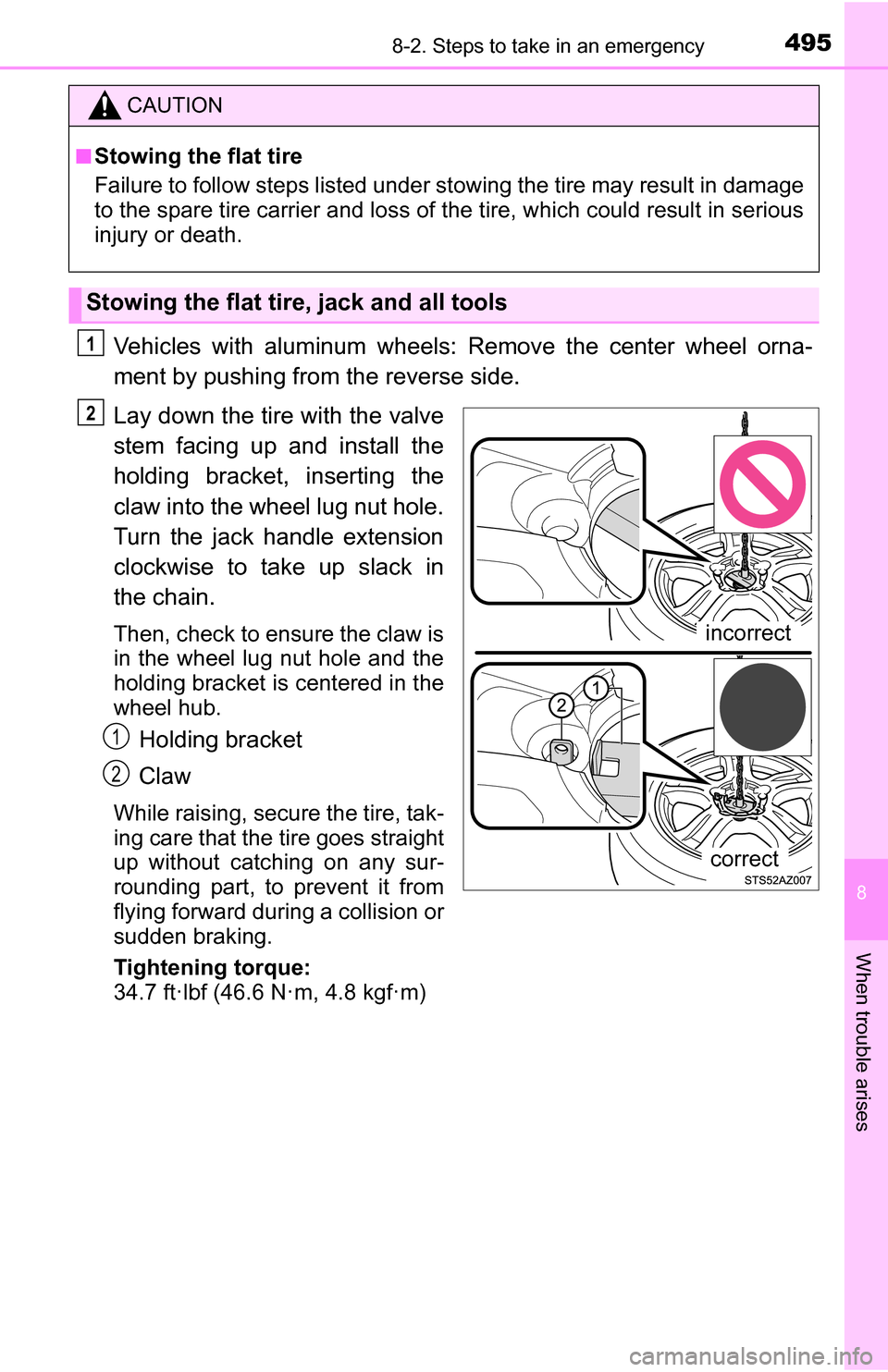
4958-2. Steps to take in an emergency
8
When trouble arises
Vehicles with aluminum wheels: Remove the center wheel orna-
ment by pushing from the reverse side.
Lay down the tire with the valve
stem facing up and install the
holding bracket, inserting the
claw into the wheel lug nut hole.
Turn the jack handle extension
clockwise to take up slack in
the chain.
Then, check to ensure the claw is
in the wheel lug nut hole and the
holding bracket is centered in the
wheel hub.
Holding bracket
Claw
While raising, secure the tire, tak-
ing care that the tire goes straight
up without catching on any sur-
rounding part, to prevent it from
flying forward during a collision or
sudden braking.
Tightening torque:
34.7 ft·lbf (46.6 N·m, 4.8 kgf·m)
CAUTION
■Stowing the flat tire
Failure to follow steps listed under st owing the tire may result in damage
to the spare tire carrier and loss of the tire, which could result in serious
injury or death.
Stowing the flat tire, jack and all tools
1
incorrect
correct
2
1
2
Page 496 of 588

4968-2. Steps to take in an emergency
Confirm it is not loose after
tightening:Push and pull the tire
Try rotating
Visually check to ensure tire is
not hung on surrounding parts.
If looseness or misassembly exists, repeat step and step .
Repeat step , any time the ti re is lowered or disturbed.
Stow the tools and jack securely.
■The temporary spare tire
●The temporary spare tire is identified by the label “TEMPORARY USE
ONLY” on the disc wheel.
Use the temporary spare tire temporarily, and only in an emergency.
●Make sure to check the tire inflation pressure of the temporary spare
tire. ( P. 526)
■After completing the tire change
The tire pressure warning system must be reset. ( P. 426)
■When reinstalling the wheel ornament (on some models)
P. 4 3 6
■When using the temporary spare tire
As the temporary spare tire is not equipped with the tire pressure warning
valve and transmitter, low inflation pressure of the spare tire will not be
indicated by the tire pressure warning system. Also, if you replace the
temporary spare tire after the tire pressure warning light comes on, the
light remains on.
■If you have a flat rear tire on a road covered with snow or ice
Install the temporary spare tire on one of the front wheels of the vehicle.
Perform the following steps and fit tire chains to the rear tires:
Replace a front tire with the temporary spare tire.
Replace the flat rear tire with the tire removed from the front of the
vehicle.
Fit tire chains to the rear tires.
3
1
2
23
43
5
1
2
3
Page 498 of 588
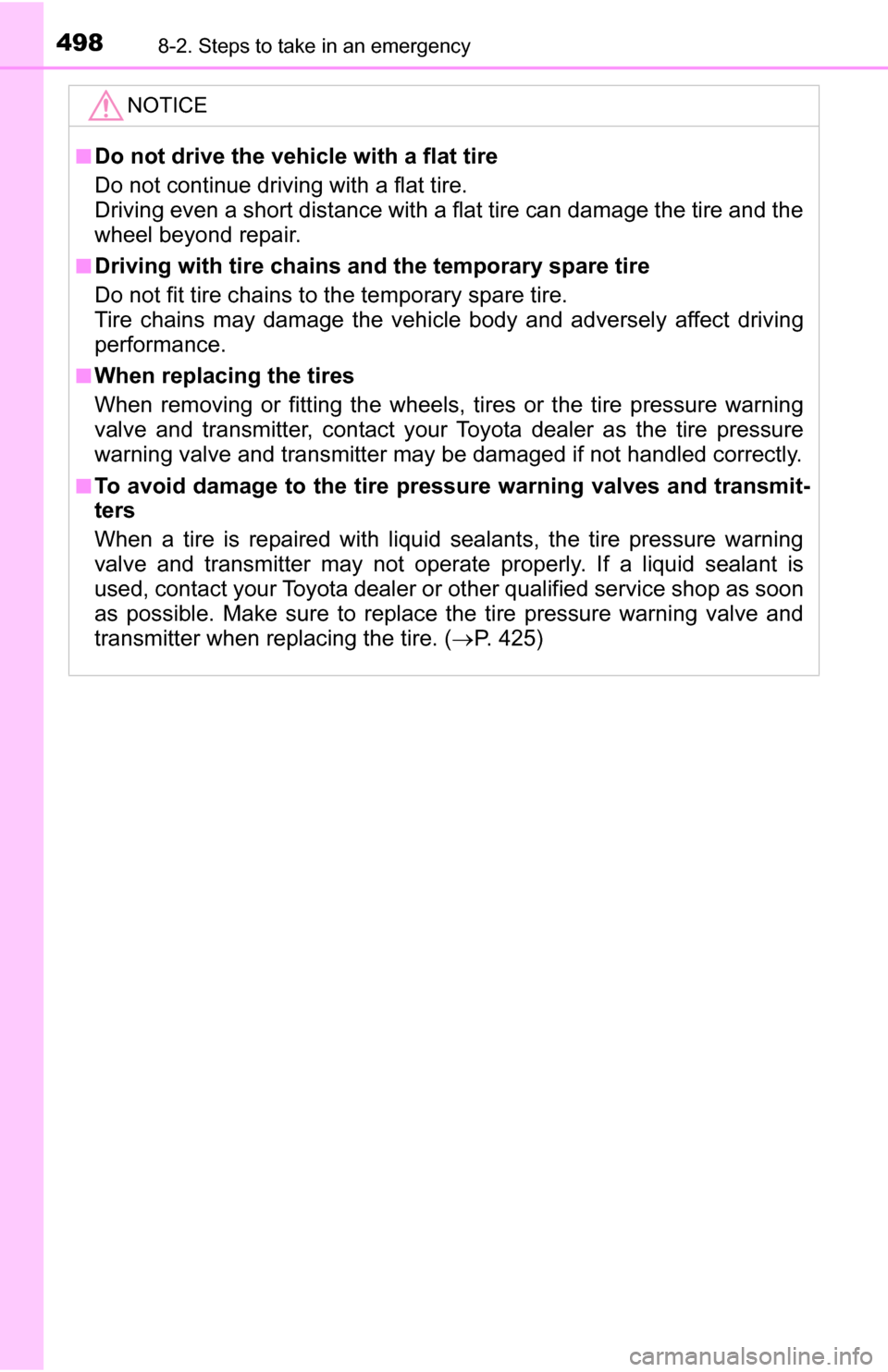
4988-2. Steps to take in an emergency
NOTICE
■Do not drive the vehicle with a flat tire
Do not continue driving with a flat tire.
Driving even a short distance with a flat tire can damage the tire and the
wheel beyond repair.
■Driving with tire chains and the temporary spare tire
Do not fit tire chains to the temporary spare tire.
Tire chains may damage the vehicle body and adversely affect driving
performance.
■When replacing the tires
When removing or fitting the wheels, tires or the tire pressure warning
valve and transmitter, contact your Toyota dealer as the tire pressure
warning valve and transmitter may be damaged if not handled correctly.
■To avoid damage to the tire pressure warning valves and transmit-
ters
When a tire is repaired with liquid sealants, the tire pressure warning
valve and transmitter may not operate properly. If a liquid sealant is
used, contact your Toyota dealer or other qualified service shop as soon
as possible. Make sure to replace the tire pressure warning valve and
transmitter when replacing the tire. ( P. 425)
Page 526 of 588
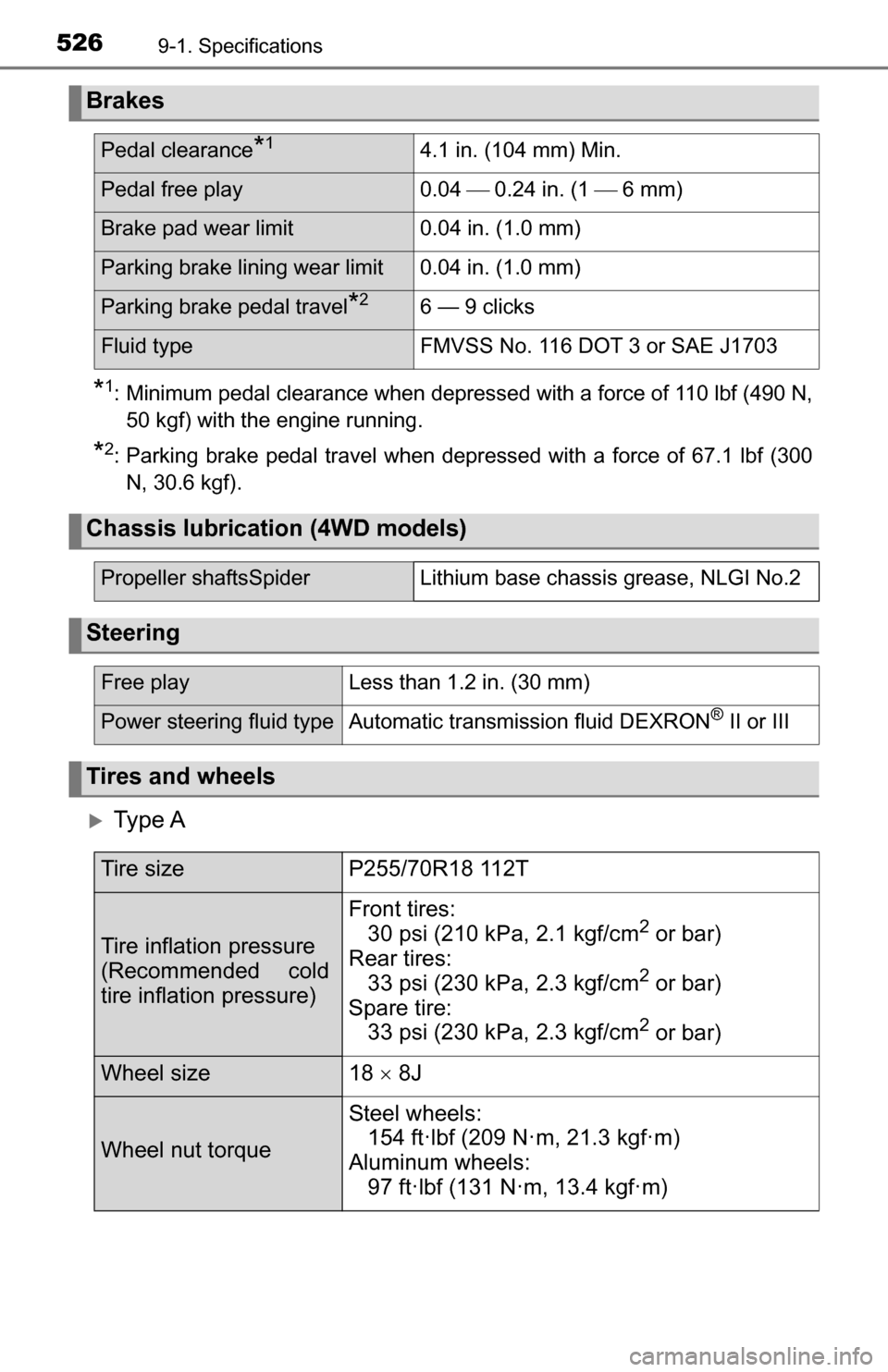
5269-1. Specifications
*1: Minimum pedal clearance when depressed with a force of 110 lbf (490 N,
50 kgf) with the engine running.
*2: Parking brake pedal travel when depressed with a force of 67.1 lbf (300 N, 30.6 kgf).
Ty p e A
Brakes
Pedal clearance*14.1 in. (104 mm) Min.
Pedal free play 0.04 0.24 in. (1 6 mm)
Brake pad wear limit0.04 in. (1.0 mm)
Parking brake lining wear limit 0.04 in. (1.0 mm)
Parking brake pedal travel*26 — 9 clicks
Fluid type FMVSS No. 116 DOT 3 or SAE J1703
Chassis lubrication (4WD models)
Propeller shaftsSpider Lithium base chassis grease, NLGI No.2
Steering
Free playLess than 1.2 in. (30 mm)
Power steering fluid typeAutomatic transmission fluid DEXRON® II or III
Tires and wheels
Tire sizeP255/70R18 112T
Tire inflation pressure
(Recommended cold
tire inflation pressure)
Front tires:
30 psi (210 kPa, 2.1 kgf/cm2 or bar)
Rear tires: 33 psi (230 kPa, 2.3 kgf/cm
2 or bar)
Spare tire: 33 psi (230 kPa, 2.3 kgf/cm
2 or bar)
Wheel size18 8J
Wheel nut torque
Steel wheels:
154 ft·lbf (209 N·m, 21.3 kgf·m)
Aluminum wheels: 97 ft·lbf (131 N·m, 13.4 kgf·m)